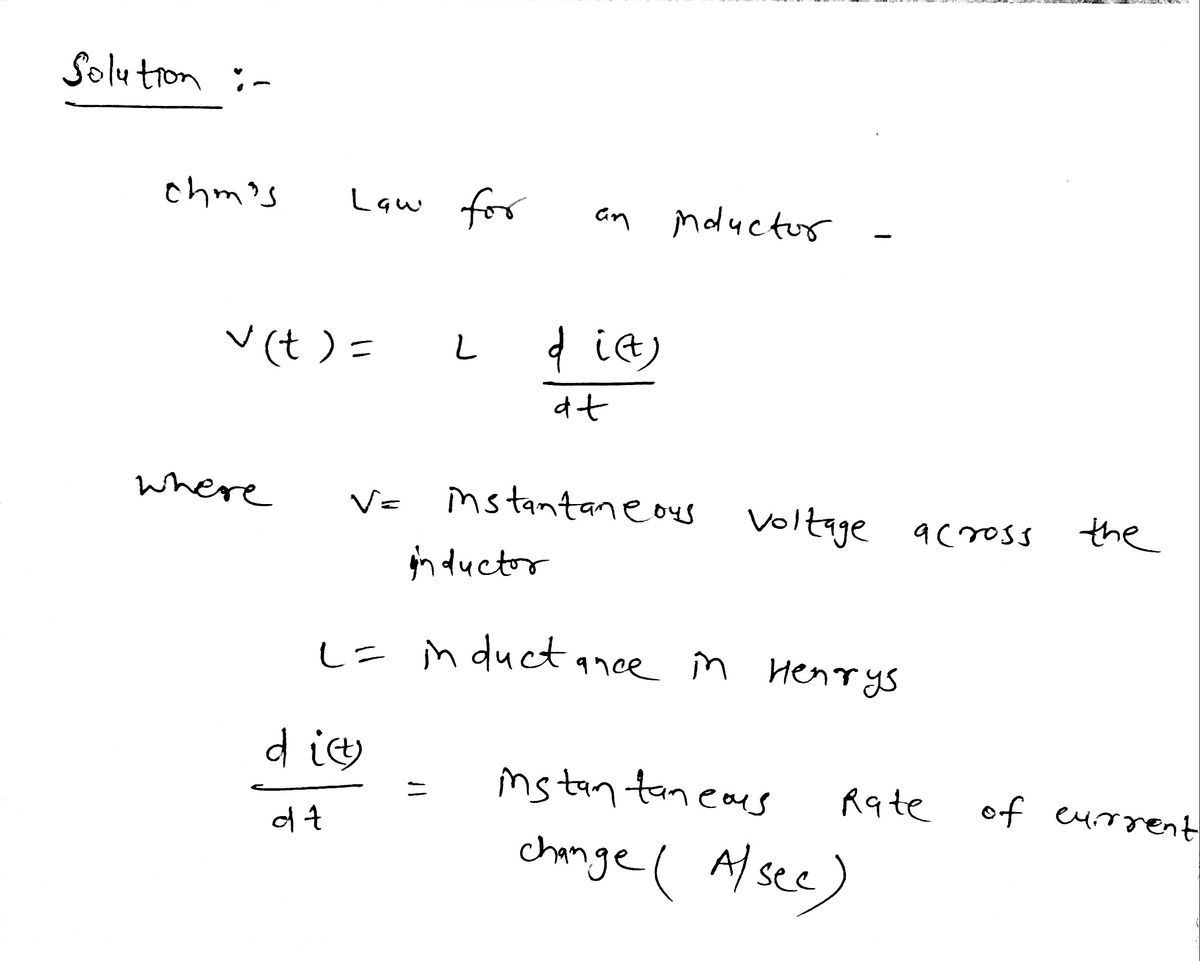Which of the following equations is true for an inductor?
Introductory Circuit Analysis (13th Edition)
13th Edition
ISBN:9780133923605
Author:Robert L. Boylestad
Publisher:Robert L. Boylestad
Chapter1: Introduction
Section: Chapter Questions
Problem 1P: Visit your local library (at school or home) and describe the extent to which it provides literature...
Related questions
Question
Please answer correctly. Thank you
![The image presents a multiple-choice question on electronics. The question asks:
"Which of the following equations is true for an inductor?"
There are four options:
1. \( v(t) = L \, i(t) \)
2. \( v(t) = L \, \frac{di(t)}{dt} \)
3. \( i(t) = L \, \frac{dv(t)}{dt} \)
4. \( i(t) = L \, v(t) \)
Explanation:
- \( v(t) \) represents the voltage across the inductor at time \( t \).
- \( i(t) \) represents the current through the inductor at time \( t \).
- \( L \) is the inductance of the inductor.
- \( \frac{di(t)}{dt} \) is the derivative of current with respect to time, indicating the rate of change of current.
- \( \frac{dv(t)}{dt} \) is the derivative of voltage with respect to time, indicating the rate of change of voltage.
For an inductor, the correct equation is:
\[ v(t) = L \, \frac{di(t)}{dt} \]
This represents the fundamental relationship for inductors, showing that the voltage across an inductor is proportional to the rate of change of current through it.](/v2/_next/image?url=https%3A%2F%2Fcontent.bartleby.com%2Fqna-images%2Fquestion%2Fd65464ea-20ac-437a-9b4f-902b3affc00d%2Fc20c79ef-c7e5-489a-ae9e-c3a356410876%2Fqopqp8_processed.jpeg&w=3840&q=75)
Transcribed Image Text:The image presents a multiple-choice question on electronics. The question asks:
"Which of the following equations is true for an inductor?"
There are four options:
1. \( v(t) = L \, i(t) \)
2. \( v(t) = L \, \frac{di(t)}{dt} \)
3. \( i(t) = L \, \frac{dv(t)}{dt} \)
4. \( i(t) = L \, v(t) \)
Explanation:
- \( v(t) \) represents the voltage across the inductor at time \( t \).
- \( i(t) \) represents the current through the inductor at time \( t \).
- \( L \) is the inductance of the inductor.
- \( \frac{di(t)}{dt} \) is the derivative of current with respect to time, indicating the rate of change of current.
- \( \frac{dv(t)}{dt} \) is the derivative of voltage with respect to time, indicating the rate of change of voltage.
For an inductor, the correct equation is:
\[ v(t) = L \, \frac{di(t)}{dt} \]
This represents the fundamental relationship for inductors, showing that the voltage across an inductor is proportional to the rate of change of current through it.
Expert Solution
Step 1

Step by step
Solved in 2 steps with 2 images

Recommended textbooks for you

Introductory Circuit Analysis (13th Edition)
Electrical Engineering
ISBN:
9780133923605
Author:
Robert L. Boylestad
Publisher:
PEARSON

Delmar's Standard Textbook Of Electricity
Electrical Engineering
ISBN:
9781337900348
Author:
Stephen L. Herman
Publisher:
Cengage Learning

Programmable Logic Controllers
Electrical Engineering
ISBN:
9780073373843
Author:
Frank D. Petruzella
Publisher:
McGraw-Hill Education

Introductory Circuit Analysis (13th Edition)
Electrical Engineering
ISBN:
9780133923605
Author:
Robert L. Boylestad
Publisher:
PEARSON

Delmar's Standard Textbook Of Electricity
Electrical Engineering
ISBN:
9781337900348
Author:
Stephen L. Herman
Publisher:
Cengage Learning

Programmable Logic Controllers
Electrical Engineering
ISBN:
9780073373843
Author:
Frank D. Petruzella
Publisher:
McGraw-Hill Education

Fundamentals of Electric Circuits
Electrical Engineering
ISBN:
9780078028229
Author:
Charles K Alexander, Matthew Sadiku
Publisher:
McGraw-Hill Education

Electric Circuits. (11th Edition)
Electrical Engineering
ISBN:
9780134746968
Author:
James W. Nilsson, Susan Riedel
Publisher:
PEARSON

Engineering Electromagnetics
Electrical Engineering
ISBN:
9780078028151
Author:
Hayt, William H. (william Hart), Jr, BUCK, John A.
Publisher:
Mcgraw-hill Education,